The ups and downs of a 2.7L Turbo
Collapse
X
-
I think steering feel is improved because the sway bar mounts to the strut as well as the tie rods and steering rack (to the knuckle), so more of the road undulations and bumps are felt through the steering wheel.Comment
-
When you steer both the positions of the mounts turn, and this will result in a extra load on your sway bar.
With other words: the swaybar will be extra twisted compared to taking a corner without M3 endlinks, and so keeping the car level.Comment
-
Riiight. I didn't think of that
Carry on!Comment
-
My friend got the exhaust video off his GoPro last night and sent it to me. Here it is, let me know what you think!
Comment
-
Been pretty busy the last few weeks. I recently moved into a new house where I have my own garage! First time in my life having my own garage space so I'm pretty stoked about that :)
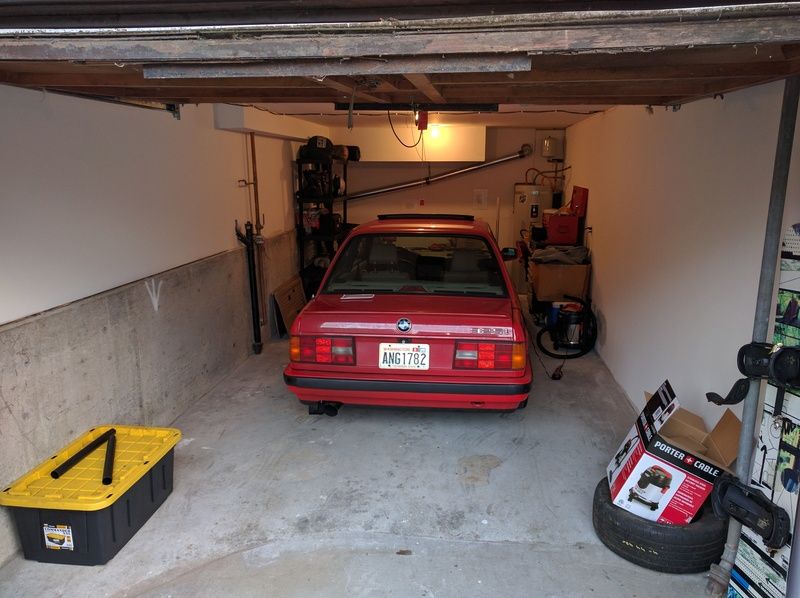
Aside from moving I was able to get the car aligned last week so I could make it out to the Old School Reunion Car Show this weekend. I spent a good portion of Saturday getting the car washed and vacuumed for the show on Sunday. As much as I see imperfections in the body and paint, the car cleans up pretty well when its all washed up.
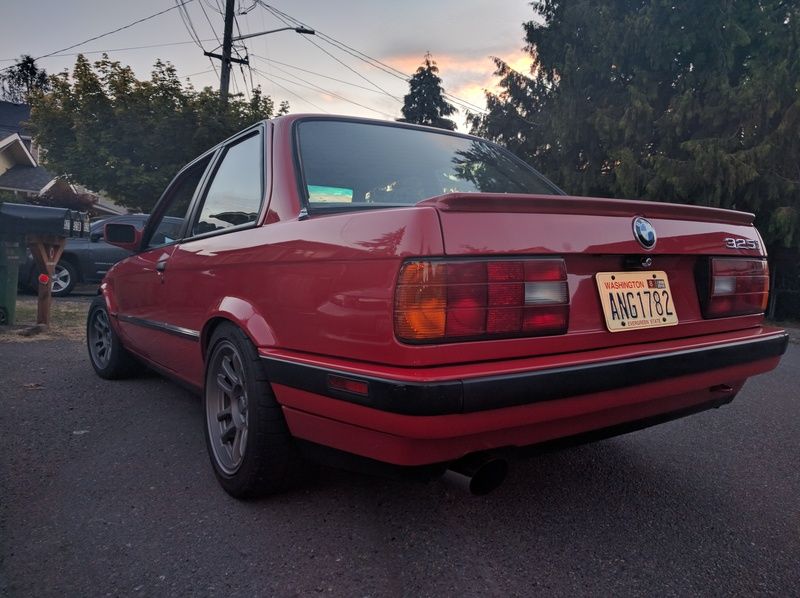
At the car show I saw that the car that donated its heart to make my car and road trip last year a possibility, Hennae30. Absolutely gorgeous car, engine bay, interior, you name it. So clean, so fresh.
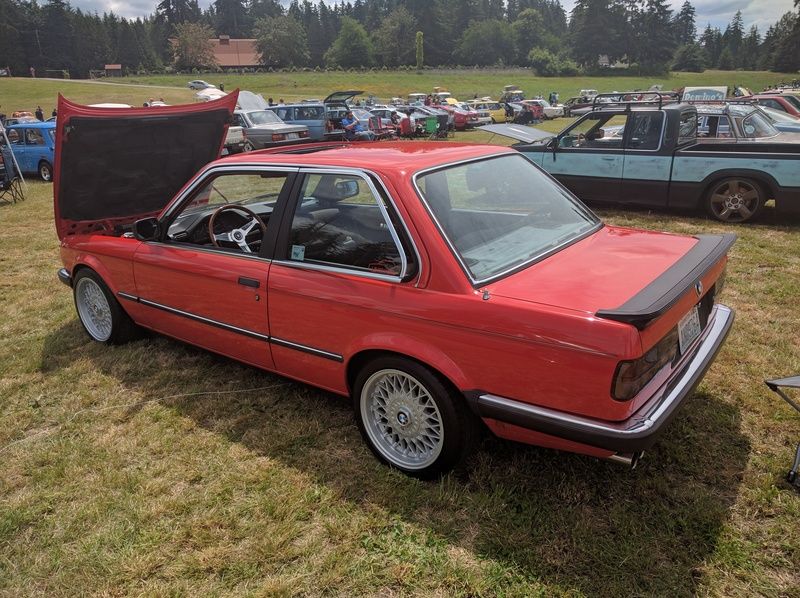
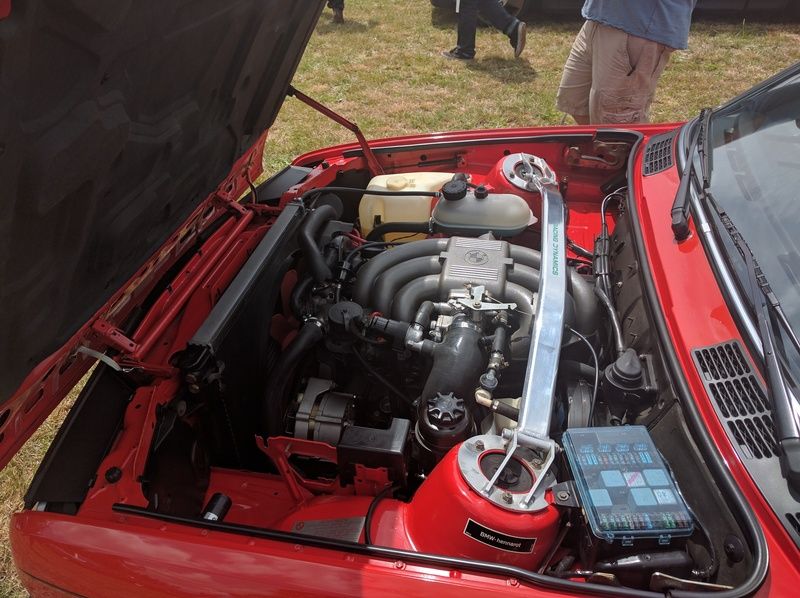
That's it for recent updates, the tune really needs work soon. So I'll focus on getting that dialed in in the near future.Comment
-
It's been a while since I've updated this thread but I've slowly been working on the tune and some other small things.
I picked up a 95 Miata from my dad's friend at the beginning of the summer which has taken some time away from the e30. The paint was extremely oxidized and had been poorly taken car of by the PO. After giving the paint a go by hand and it taking forever I decided to buy a DA polisher. I've always been curious about how to use a DA polisher so I picked up a Porter Cable off Amazon and watched a series of videos by Junkman2000 on YouTube. If any of you are interested in learning about detailing I would highly recommend his videos. His videos are a little long but very informative, so they take a bit to get through but he will have you polishing like a pro by the end of his videos. Here are some pictures of how the miata looked before and after
Before the first wash:
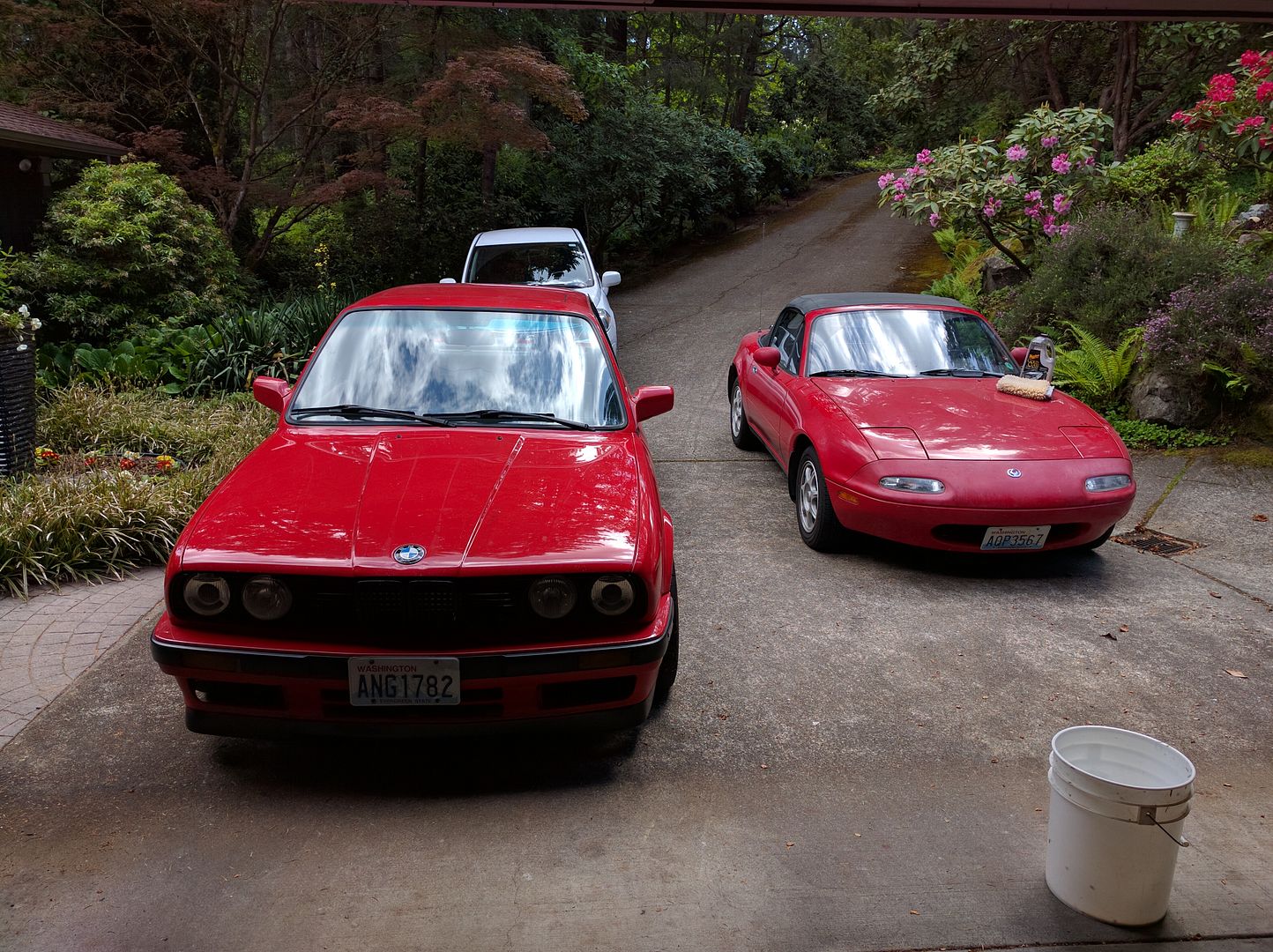
Up close of the rear bumper before:
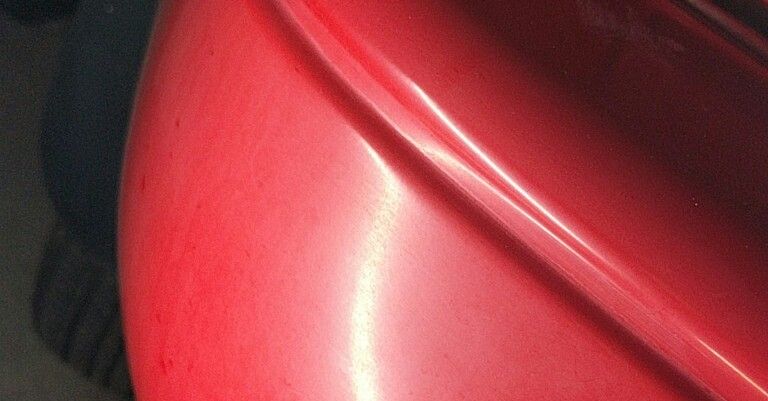
Up close of the rear bumper after:

Side shot of the car a few days after I finished the paint correction:

I also installed a catback exhaust while doing the detail since the stock exhaust was a little buzzy. The new exhaust has a nice deep tone and looks nice too.
As for the e30, I've been driving it to work more often to utilize the remaining nice weather for tuning. I will say there is a TON to learn to be able to tune a car effectively, safely and reliably. I tried to tune the engine on my way home from work whenever I drove the e30 since it gave me a little bit of city driving, traffic, highway, freeway, etc. Just when I think I would get the tune right one day, the next morning I would start it up and there would be some issue. The first thing I realized was causing variability in the base VE map in MS was the MAT Air Density table. It is set up out of the box to replicate the ideal gas law, which sounds great but in practice it makes it extremely hard to get the tune exactly right. One day it would be hot and pull fuel while I was trying to tune, and the next morning it would be cold and super rich. To avoid this I adjusted the table to give 100% fuel throughout normal IAT temps (cruising to just beginning to heat soak):
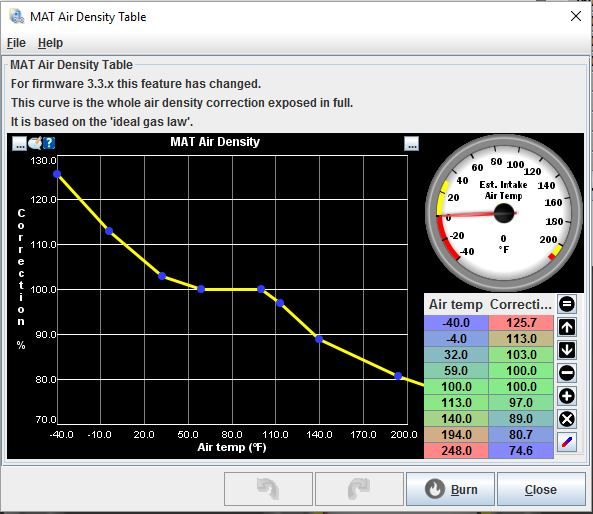
Some other good settings to check for driveability tuning are cold spark advance, Idle advance timing, accel enrichment and warmup enrichment. A good way to see what corrections are being made to your fuel and spark are the fuel and timing calculations summaries. Those helped me find the specific issues in the tune if the car wasn't doing what I expected. I was running into the issue of the car bucking a lot during cruising 2-3.5k rpm. In attempt to eliminate the bucking I initially tried pulling timing which worked to an extent, but didn't completely fix the issues. I was aiming for 15.0:1 AFR during cruise but that seems to be a little lean for my setup. Finally last night I was able to dial it in so it virtually never bucks while cruising around town and doing spirited pulls. DISCLAIMER, I don't really know what I am doing, this has just been my educated guess at tuning lol. Here is what I've come up with for an AFR Map:
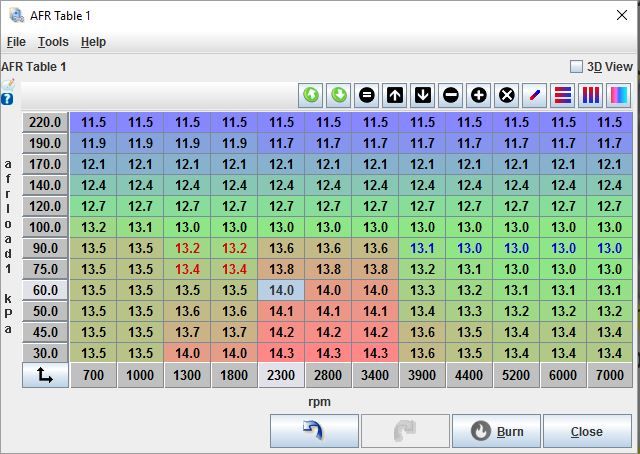
I used the auto tune feature to tune the VE table based on the target AFR Table. Using the auto tune is much faster than taking logs and iterating over and over again, but both have their advantages. Here is the VE table I've gotten using the auto tune:
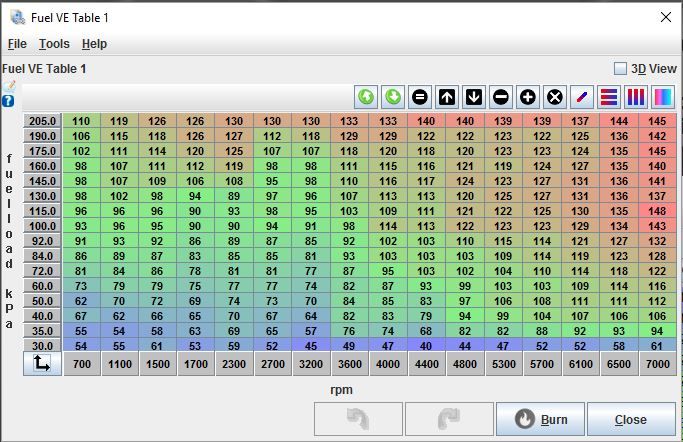
I found a spark table for a similarly setup car and used that as a starting point. I ended up retarding the timing across most of the map for safety since I don't really know what I'm doing and learning as I go. I took timing out until it drove smoothly yet was still powerful according to the butt dyno. Here is what it looks like as of now:
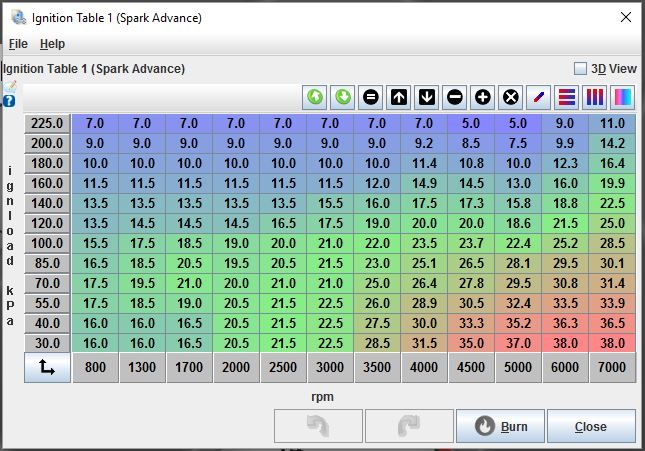
I would love some feedback on my maps above since I'm still learning, let me know what you think.
I also just changed the oil last night since it had been a while. I switched to 10W-60 since I had a hunch the 15W-50 I was running in it was degrading due to heat. My thought is that stock calls for 20W-50, I added a turbo which adds heat, without upgrading the oil cooling system which likely means the oil is seeing too much heat even though its synthetic. So I figure I'll see how a heavier oil does. I found Liqui-Moly Synthetic on Amazon for $40 a jug, cheaper than the Mobil 1.
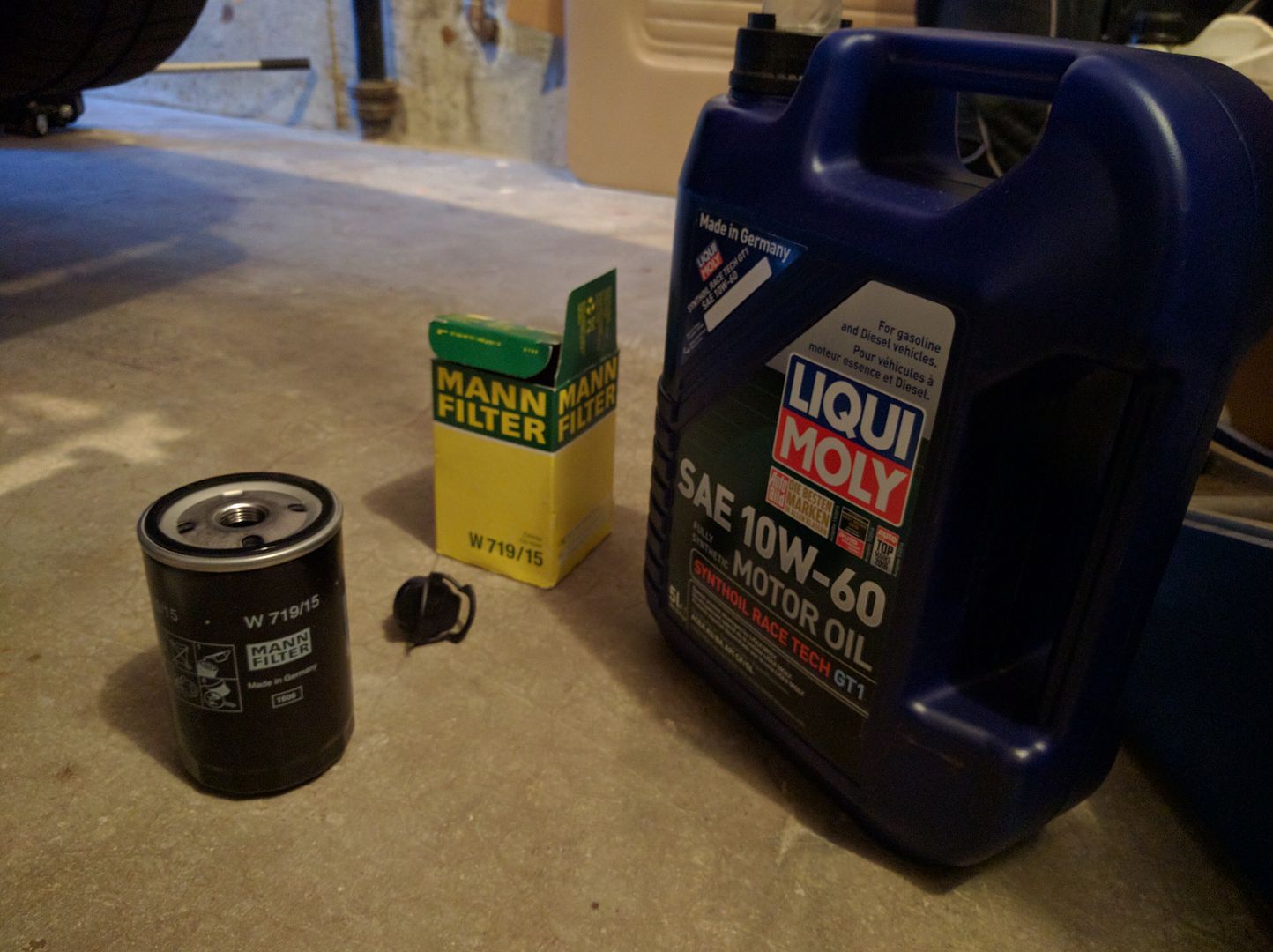
So far the oil pressure seems slightly higher with this oil, around 20psi at idle. I'll post back with how it holds up over time, but the reviews on amazon were all positive mostly from BMW guys.
I noticed while doing the oil change that this engine is burning quite a lot of oil. From the last oil change I've added about 1.5 quarts of oil, and there was only 3 quarts of oil in the pan. That means that 4.5-1.5+1.5=4.5-1.5=3 Quarts in pan, 3 quarts burned... I think the ETA rings can't keep up with the extra power, or they are tired. So I'm considering rebuilding the 2.5L bottom end I have sitting in the garage, and swapping that in during the fall/winter.Comment
-
That's a pretty conservative ignition advance table for a low compression engine like yours. From what I've seen the combo you're running puts you at ~8.4:1. If your AFRs are spot on across the rev range I think it's time to start adding advance to pick up some power. One degree at a time with your ears on alert and you'll be safe. You could also lean your cruising and idle target AFR out quite a bit, you might pick up a couple of mpg. (edit) just saw the bit about you running into bucking at cruise. Your timing advance isn't the problem here imo, you could probably run another 5-10 degrees of advance in the cruise range without causing any issues. What kind of fuel injectors are you running? I ask because if they're big you might be running into minimum pulsewidth issues.Last edited by varg; 09-24-2016, 08:18 AM.Comment
-
I agree, and I was wondering why it wouldn't take any timing during cruise. I'm running Bosch 55lb/hr injectors with an injector dead time of 1.130ms. Is my dead time way too long? What would you suggest I do to get rid of the bucking during cruise?That's a pretty conservative ignition advance table for a low compression engine like yours. From what I've seen the combo you're running puts you at ~8.4:1. If your AFRs are spot on across the rev range I think it's time to start adding advance to pick up some power. One degree at a time with your ears on alert and you'll be safe. You could also lean your cruising and idle target AFR out quite a bit, you might pick up a couple of mpg. (edit) just saw the bit about you running into bucking at cruise. Your timing advance isn't the problem here imo, you could probably run another 5-10 degrees of advance in the cruise range without causing any issues. What kind of fuel injectors are you running? I ask because if they're big you might be running into minimum pulsewidth issues.
I just installed VirtualDyno today, so I'm planning on logging some pulls and adding in some timing until power stops increasing and then backing the timing off a degree or so.
Thanks for the input!Comment
-
That dead time seems too long, about twice what I would expect it to be at 13.2V. There should be a datasheet for your injectors out there for you to refer to for dead time and minimum pulsewidth, input the correct value for dead time and adjust your tune as necessary. 55lb/hr injectors are pretty large, so you may run into minimum pulsewidth limitations trying to lean the cruise and idle out. If you lean it out past a certain point and the AFR becomes unstable you will know you're running into the minimum pulsewidth. It's fairly easy to calculate the current pulsewidth of your injectors given a few variables.
PW = REQ_FUEL * VE * MAP * E + accel + dead time
Where "E" is the average of all enrichments/corrections (use 1 for this and 0 for accel). Once you've found your minimum pulsewidth and correct dead time, you just plug in everything else, set the equation to the minimum pulsewidth, and go row by row (MAP values in your VE table), solving for the VE. You'll find out what your minimum VE value is for that particular row this way and can increase any cells below this value to maintain consistent injector performance.Comment
-
So lowering my dead time made my VE table pretty crazy. I was getting values of 75 or so at idle so I'm not sure that is my issue. For the time being I set it 1.2ms since that seemed to give me stable AFRs at idle.
One thing I decided to mess with was the Injector Staging setting. It was on 2 Squirts/alternating, and I changed it to 2 squirts/simultaneous. My reasoning behind this is that with 2squirts/alternating, all the fuel is most likely being shot out of rotation and might be pooling. With 2squirts/simultaneous only half the fuel is being shot at a closed valve and the other half might be somewhat closer to a valve opening event. The results seemed fairly positive. During cruise I was able to increase timing and lean out the AFRs without the car bucking. The car also feels slightly smoother throughout the rev range and driving around. I'm not sure if this is a placebo effect or if it really is running better. Anyone have input on this?
I did log a 3rd gear pull going onto an on-ramp and threw the results in Virtual Dyno to see what kind of power the car is making. On 10-11lbs I'm fairly happy with the results, but my AFRs are off a bit across the board. Check it out:
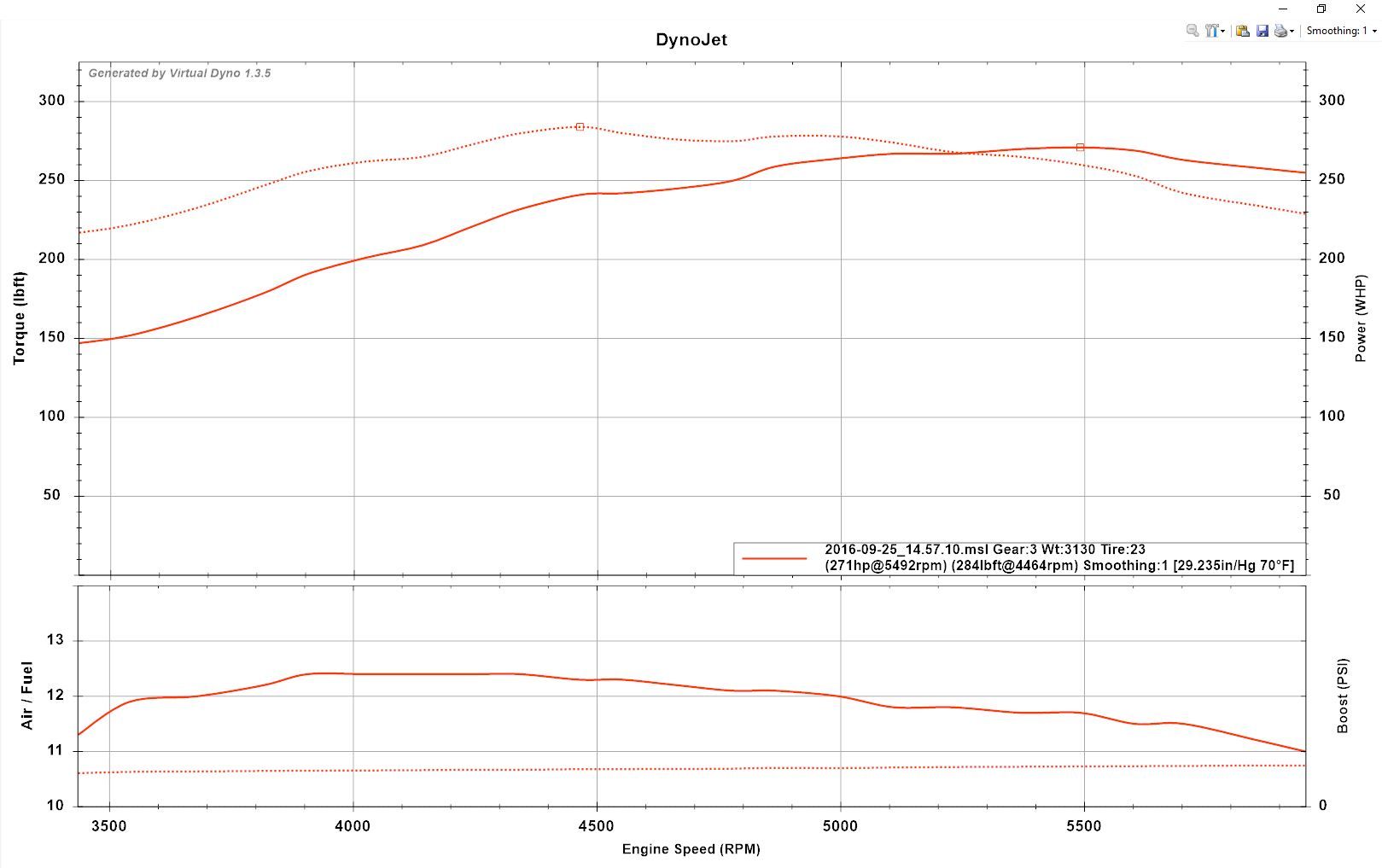
The plan now is to work on getting the fueling table dialed in, then add in timing and use Virtual Dyno to check power gains.Comment
-
If you're using 2 squirts alternating and have no cam reference it could very well be squirting on mostly closed valves. The reason your VE values went up with a smaller dead time is the fact that the equation adds the dead time to the pulsewidth. If your real dead time is .6 and you're running 1.2 you've added an additional .6ms to every pulsewidth so your VE values might be artificially low. FWIW my VE value at idle is 69, which is higher than I usually see, but my tune is dead on. I would aim for a flat 11.5:1 AFR from full boost to redline, it's a nice safe AFR. I'm not sure when your boost comes on but 12.5:1 in full boost is lean for the tuning I'd do on someone else's car, I'm at around 11.8:1 at 10psi on my own car, and 11.5:1 at 18psi. It's a street car, I'd rather sacrifice a few hp to a slightly rich mixture than run a 'best power' mixture.Comment
-
Yeah I understand why the VE table values increased substantially. I took a look at my injectors, and while I believe they are 55lb/hr injectors, I'm not sure they are Bosch 55lb/hr injectors. I bought them second hand and the PO said they were "Bosch 55#" injectors but I'm not really sure how I would be able to check. So based on not knowing exactly what injectors I have, and being a bit skeptical of the VE value I went back to a longer dead time. Your VE values at idle do give me a bit more confidence, so I'll try tuning the setup with a lower dead time again and see what happens.If you're using 2 squirts alternating and have no cam reference it could very well be squirting on mostly closed valves. The reason your VE values went up with a smaller dead time is the fact that the equation adds the dead time to the pulsewidth. If your real dead time is .6 and you're running 1.2 you've added an additional .6ms to every pulsewidth so your VE values might be artificially low. FWIW my VE value at idle is 69, which is higher than I usually see, but my tune is dead on. I would aim for a flat 11.5:1 AFR from full boost to redline, it's a nice safe AFR. I'm not sure when your boost comes on but 12.5:1 in full boost is lean for the tuning I'd do on someone else's car, I'm at around 11.8:1 at 10psi on my own car, and 11.5:1 at 18psi. It's a street car, I'd rather sacrifice a few hp to a slightly rich mixture than run a 'best power' mixture.
I agree with your AFR values, I adjusted my AFR table so it should be at 11.5 from full boost to redline. I need to spend some more time logging and using Tune Analyze to get it dialed in and then I'll start adding timing back in. Thanks for your help in trying to figure this out!Last edited by cleanasse30; 09-26-2016, 09:11 AM.Comment
-
You would have to take a few injectors to be flow tested, assuming they were modified injectors and the P/N on them means nothing.
You should be able to get a pretty good idea of injector size from idle fuel tuning. Something that helps is a voltmeter reading the main 12v. You should be seeing 13.5-14 volts, but here you want to make voltage steady. A bad idle, or much ECU correction will lead voltage to jump around, or be out of spec. Anyway, once that's pretty steady you should have an idea of injector flow rate (if you don't want to take them out and to a shop).
FWIW most cars, from factory, have fuel compensation more similar to what you've done on the compensation map.
Your ignition map is a little off. Why is your cruising ignition so low? What is the compensation?Comment
-
Thanks for the suggestions. Initially when I was tuning the car, I was still getting hesitation at low loads during cruise with more advanced timing. To eliminate the hesitation I had to pull timing, leading me to the timing map above. I think the cause of the hesitations/bucking was some other issue, which I think I have identified. Going from 2squirts/alternating to 2squirts/simultaneous has allowed me to run more advanced timing and leaner AFRs while cruising with no hesitations. I believe this was caused by having virtually all the fuel being sprayed when the engine was off rotation.You would have to take a few injectors to be flow tested, assuming they were modified injectors and the P/N on them means nothing.
You should be able to get a pretty good idea of injector size from idle fuel tuning. Something that helps is a voltmeter reading the main 12v. You should be seeing 13.5-14 volts, but here you want to make voltage steady. A bad idle, or much ECU correction will lead voltage to jump around, or be out of spec. Anyway, once that's pretty steady you should have an idea of injector flow rate (if you don't want to take them out and to a shop).
FWIW most cars, from factory, have fuel compensation more similar to what you've done on the compensation map.
Your ignition map is a little off. Why is your cruising ignition so low? What is the compensation?
As for the injectors, I'm fairly sure they are 55# injectors, I just don't know if they are modified injectors or factory injectors. I would guess they are modified to reach 55lb/hr flow rates which makes finding the dead times for them extremely hard.
I read about a method of finding dead times by increasing the number of squirts and seeing a change in AFR:
If I have time I'll try this tonight to see if it works. *EDIT* According to the way MS calculates pulse width, this above theory should work based on maths.The way to check dead time in the car is to change the number of squirts per cycle. I've done this on two separate occasions and have come to the same dead time number so it seems to be consistent.
What you want to do is let your car idle and take note of the AFR. Then change the number of squirts per cycle (either more or less depending on where you were) and observe the AFR again. It should be the same. If you get richer with more squirts / cycle, then the extra fuel is coming from extra dead time every squirt. If you get leaner with more squirts, then you have not enough dead time. It's an iterative process. Make sure you never idle the engine at a very low PW because it may throw you off if you're near the non-linear part of the injector PW. I had to use 1 squirt, and 2 squirts.
Lastly, after tuning a perfect dead time of .870ms for my injectors, I ended up running a dead time of 1.3ms and re-tuning VE to match. Why the wrong dead time? My car just runs better like that. I have pretty big injectors and idle at a pretty low PW. With the correct dead time set, the car would not like to idle at anything leaner than 12.7:1. With the exaggerated dead time, I can idle at 16:1 if I wanted to. EAE works way better now too and various other things have improved. I say this so you don't get too hung up on setting perfect dead time and feel free to see what your engine "likes".Last edited by cleanasse30; 09-26-2016, 01:14 PM.Comment



Comment